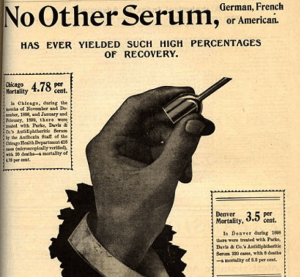
In spite of FDA and FTC regulation of drug ads, misleading claims may be more prevalent than viewers might expect. Source: Wikimedia.
“Crush. Kill. Destroy.” Ertaczo cream will wipe out the fungus that is causing your athlete’s foot—at least, so Johnson & Johnson claimed. Unfortunately, the evidence doesn’t back up this claim; the two studies included in Ertaczo’s product labeling mention complete cure rates of 13.1% and 27.2% — at best, this medicine completely cured patients a quarter of the time (1).
According to a recent study of TV drug advertising published in the Journal of General Internal Medicine by Adrienne Faerber and David Kreling, misleading ads are extremely common. The study analyzed the major claims in 84 prescription and 84 non-prescription TV drug ads, finding that overall only 33% of claims were true, while 57% were potentially misleading and 10% were unfounded and false. However, prescription drug ads tended to be more truthful, with more true claims (43%) and fewer false claims (2%), as compared to nonprescription drug ads, which had 23% true claims and 17% false claims. The amount of misleading claims was roughly equivalent between the two groups (2).
Misleading claims, in turn, were broken into three categories in Faerber and Kreling’s study: selected facts, minimal facts and nonfacts. A selected facts claim omitted important facts about the drug; for instance, the claim “Claritin Liquigels are new” omitted the fact that the liquid-filled capsule was otherwise identical to the tablet that had been around for many years.
Minimal facts claims drew exaggerated conclusions from the clinical evidence; for instance, the claim “Nothing works better than Prevacid” implies that it is the best heartburn medicine available, when in fact the evidence showed that it is merely equally effective as several others. Finally, nonfacts claims usually presented some immeasurable characteristic not directly related to the drug; for example, the claim, “AlkaSeltzer is the official cold medicine of the US Ski Team” said nothing about its actual effectiveness (2).
This study drew criticism from Matthew Bennett, Senior Vice President of the Pharmaceutical Research and Manufacturers of America. He called the study a “subjective, non-rigorous analysis of a small group of direct-to-consumer advertisements,” with his primary concern being an overbroad definition of misleading—he notes that some of the statements classified as such did not violate FDA laws on advertising practices (3).
However, the study did not assert to have identified illegal advertising practices, and the researchers admitted to having set a high standard for truthfulness in advertising. They believed it important to recognize that there are many claims which, while not illegal according to the FDA, may nonetheless in practice be misleading to the consumer.
In response to the comment that the study was subjective and non-rigorous, Faerber noted that this is the biggest analysis of TV drug advertising to date, with the runner-up having a sample size of 115. Additionally, neither she nor Kreling were directly involved in the classification of the ads; for that, three pharmacy students were trained by her and Kreling to perform the analysis. Furthermore, the two people who reviewed each ad agreed on its categorization more than 95% of the time (2, 4).
Sources:
1) Ruiz, Rebecca, “Ten Misleading Drug Ads” (2 February 2010). Available at http://www.forbes.com/2010/02/02/drug-advertising-lipitor-lifestyle-health-pharmaceuticals-safety.html?partner=alerts (3 October 2013).
2) Faerber, Adrienne E., Kreling, David H., “Content Analysis of False and Misleading Claims in Television Advertising for Prescription and Nonprescription Drugs” (2013). Available at http://link.springer.com/content/pdf/10.1007%2Fs11606-013-2604-0.pdf
3) Plackett, Benjamin, “Study Finds Most Drug Commercials Misleading” (28 September 2013). Available at http://www.scientificamerican.com/article.cfm?id=study-finds-most-drug-commercials-misleading (1 October 2013).
4) Faerber, Adrienne E., Personal Interview, 04 October 2013.
Leave a Reply